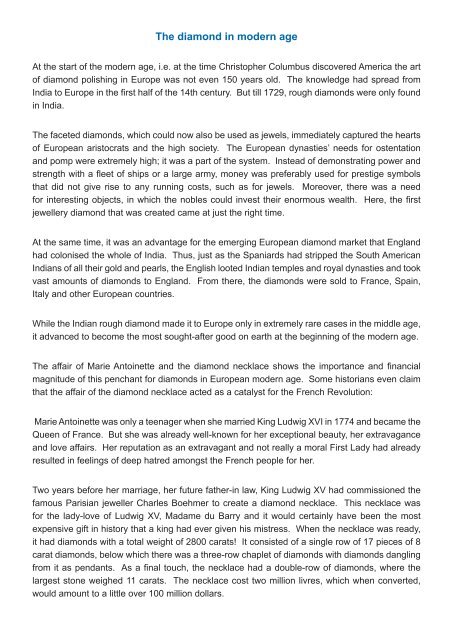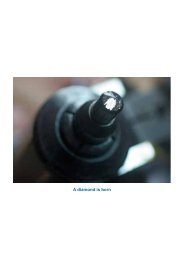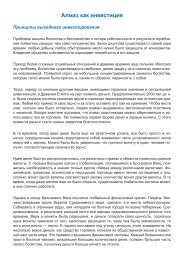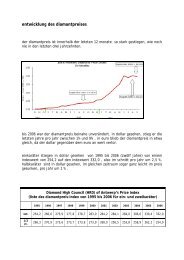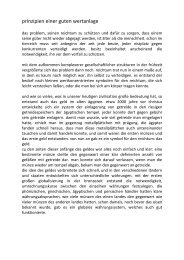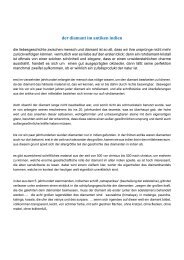The diamond in ancient India - Diamantschleiferei Michael Bonke
The diamond in ancient India - Diamantschleiferei Michael Bonke
The diamond in ancient India - Diamantschleiferei Michael Bonke
- No tags were found...
You also want an ePaper? Increase the reach of your titles
YUMPU automatically turns print PDFs into web optimized ePapers that Google loves.
<strong>The</strong> <strong>diamond</strong> <strong>in</strong> modern ageAt the start of the modern age, i.e. at the time Christopher Columbus discovered America the artof <strong>diamond</strong> polish<strong>in</strong>g <strong>in</strong> Europe was not even 150 years old. <strong>The</strong> knowledge had spread from<strong>India</strong> to Europe <strong>in</strong> the first half of the 14th century. But till 1729, rough <strong>diamond</strong>s were only found<strong>in</strong> <strong>India</strong>.<strong>The</strong> faceted <strong>diamond</strong>s, which could now also be used as jewels, immediately captured the heartsof European aristocrats and the high society. <strong>The</strong> European dynasties’ needs for ostentationand pomp were extremely high; it was a part of the system. Instead of demonstrat<strong>in</strong>g power andstrength with a fleet of ships or a large army, money was preferably used for prestige symbolsthat did not give rise to any runn<strong>in</strong>g costs, such as for jewels. Moreover, there was a needfor <strong>in</strong>terest<strong>in</strong>g objects, <strong>in</strong> which the nobles could <strong>in</strong>vest their enormous wealth. Here, the firstjewellery <strong>diamond</strong> that was created came at just the right time.At the same time, it was an advantage for the emerg<strong>in</strong>g European <strong>diamond</strong> market that Englandhad colonised the whole of <strong>India</strong>. Thus, just as the Spaniards had stripped the South American<strong>India</strong>ns of all their gold and pearls, the English looted <strong>India</strong>n temples and royal dynasties and tookvast amounts of <strong>diamond</strong>s to England. From there, the <strong>diamond</strong>s were sold to France, Spa<strong>in</strong>,Italy and other European countries.While the <strong>India</strong>n rough <strong>diamond</strong> made it to Europe only <strong>in</strong> extremely rare cases <strong>in</strong> the middle age,it advanced to become the most sought-after good on earth at the beg<strong>in</strong>n<strong>in</strong>g of the modern age.<strong>The</strong> affair of Marie Anto<strong>in</strong>ette and the <strong>diamond</strong> necklace shows the importance and f<strong>in</strong>ancialmagnitude of this penchant for <strong>diamond</strong>s <strong>in</strong> European modern age. Some historians even claimthat the affair of the <strong>diamond</strong> necklace acted as a catalyst for the French Revolution:Marie Anto<strong>in</strong>ette was only a teenager when she married K<strong>in</strong>g Ludwig XVI <strong>in</strong> 1774 and became theQueen of France. But she was already well-known for her exceptional beauty, her extravaganceand love affairs. Her reputation as an extravagant and not really a moral First Lady had alreadyresulted <strong>in</strong> feel<strong>in</strong>gs of deep hatred amongst the French people for her.Two years before her marriage, her future father-<strong>in</strong> law, K<strong>in</strong>g Ludwig XV had commissioned thefamous Parisian jeweller Charles Boehmer to create a <strong>diamond</strong> necklace. This necklace wasfor the lady-love of Ludwig XV, Madame du Barry and it would certa<strong>in</strong>ly have been the mostexpensive gift <strong>in</strong> history that a k<strong>in</strong>g had ever given his mistress. When the necklace was ready,it had <strong>diamond</strong>s with a total weight of 2800 carats! It consisted of a s<strong>in</strong>gle row of 17 pieces of 8carat <strong>diamond</strong>s, below which there was a three-row chaplet of <strong>diamond</strong>s with <strong>diamond</strong>s dangl<strong>in</strong>gfrom it as pendants. As a f<strong>in</strong>al touch, the necklace had a double-row of <strong>diamond</strong>s, where thelargest stone weighed 11 carats. <strong>The</strong> necklace cost two million livres, which when converted,would amount to a little over 100 million dollars.


